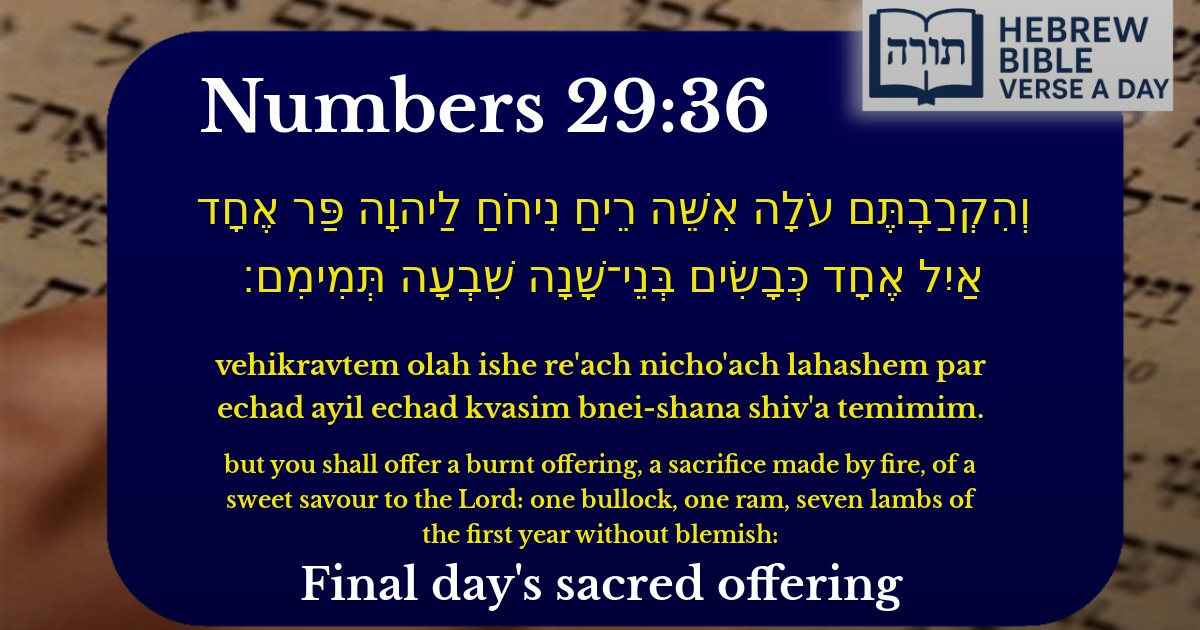Frequently Asked Questions
Q: What is the significance of the burnt offering described in Numbers 29:36?
A: The burnt offering (עֹלָה) in Numbers 29:36 is a voluntary sacrifice that is completely consumed by fire on the altar, symbolizing total devotion to Hashem. According to Rashi, this offering is called a 'sweet savor' because it is pleasing to Hashem when offered with proper intent. The specific animals (bull, ram, and lambs) represent different levels of atonement and dedication.
Q: Why does the verse specify that the lambs must be 'without blemish'?
A: The Torah requires sacrifices to be 'without blemish' (תְּמִימִם) to teach that we must offer our best to Hashem. The Rambam explains in the Mishneh Torah (Hilchot Ma'aseh HaKorbanot) that any physical defect disqualifies an animal, emphasizing the importance of giving something whole and perfect in service of G-d.
Q: What is the meaning of 'a sweet savor to the Lord' in this verse?
A: The phrase 'a sweet savor' (רֵיחַ נִיחֹחַ) means that the sacrifice is pleasing to Hashem when offered with sincerity. The Midrash (Vayikra Rabbah) explains that it is not the physical smell but the spiritual devotion behind the offering that matters. This teaches that our mitzvot should be done with pure intention.
Q: How does this verse relate to the holiday of Shemini Atzeret?
A: Numbers 29:36 is part of the Torah reading for Shemini Atzeret, the concluding festival after Sukkot. The Talmud (Sukkah 55b) explains that this additional day is a special intimate gathering with Hashem, and the unique sacrifices mentioned symbolize the close relationship between G-d and the Jewish people.
Q: Can we apply the lessons of this verse today without the Temple?
A: Yes, though we cannot bring sacrifices today, the Talmud (Berachot 17a) teaches that prayer (תְּפִלָּה) replaces sacrifices. The Rambam (Hilchot Tefillah) explains that sincere prayer, like sacrifices, requires proper intention (כַּוָנָה). Additionally, acts of kindness (גְּמִילוּת חֲסָדִים) and Torah study are considered spiritual substitutes for offerings.


Verse Context and Overview
The verse (Numbers 28:19) describes the korban olah (burnt offering) brought on the second day of Pesach (Passover) as part of the additional sacrifices (musafim) prescribed for the festival. This offering is characterized as an isheh rei'ach nichoach laHashem—"a fire-offering, a pleasing aroma to Hashem." The specific animals required are one bull, one ram, and seven unblemished male lambs in their first year.
Explanation of the Sacrifice
Rashi (on Numbers 28:19) explains that the term isheh rei'ach nichoach emphasizes that the offering is entirely consumed by fire on the altar, unlike other sacrifices where portions are eaten by the kohanim or the donors. This total dedication symbolizes complete submission to Hashem's will.
The Rambam (Hilchot Temidin uMusafin 8:1) elaborates that these additional offerings are distinct from the daily tamid sacrifices and are unique to festivals, underscoring the elevated sanctity of these days.
Significance of the Animals
Theological and Ethical Lessons
The Talmud (Menachot 110a) teaches that sacrifices are a means of drawing closer to Hashem (korban from the root karov, "to come near"). The olah, being entirely consumed, symbolizes total commitment, teaching that one must dedicate their entire being—thoughts, actions, and desires—to divine service.
Additionally, the requirement for the animals to be temimim (unblemished) underscores the importance of integrity and perfection in one's spiritual endeavors, as noted by the Sforno (on Numbers 28:19).